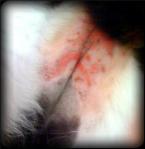Red Cat Belly Rash
The Rash Problem
Sheila was a four-year-old spayed orange-black -and-white short-haired cat with a nasty red bumpy rash on her stomach.
Sheila also had tiny red bumps lining the edges of both her ears. She licked her belly throughout most of the night and had barbered the fur on her belly down to a fine fuzz. She hated having her ears, paws, or back touched, and was generally, difficult to comfort or show affection to.
Like most cats with her symptoms, Sheila ate well. Occasionally she would vomit just foamy liquid, or a little hair from licking too much. She liked to sit and look at birds outside the living room window and liked to rub against her people’s legs in the kitchen to meow for food.
“Doctor, this rash just showed up,” said Sheila’s mom.
“Let’s take a look,” said Doc Truli.
The fur on the lower abdomen was licked short, almost bald. The area of the rash was red, heat exuded off the surface, red raised, patchy, almost serpentine patterns coalesced. A shiny, sticky, clear film coated the surface, cracking in spots where it had dried to the rash. Clearly, this kitty was uncomfortable.
Tru Useless, but Interesting Tip:
This color combination is called “calico.” If even one speck of white fur or pink pad shows, a “tortoiseshell” automatically becomes a “calico” for show purposes.
The (Un)Rash Tests
Doc Truli performed a three-slide technique analysis of the skin. Three slide technique in veterinary dermatology includes a microscopic examination of samples taken with tape, a skin scraping, and ear swabs, all three samples placed on microscope slides and analyzed. In addition, a ultraviolet “black” light trained to the area for a few minutes will excite the electrons inside 50% of ringworm fungi and make them glow a brilliant light green color.
Common Differentials (Possible Diagnosis) for Cat Skin Rash:
Eosinophilic Granuloma Complex
Autoimmune (Pemphigus…)
Bacterial, fungal (“ringworm”), or yeast infection
Parasites: mange or lice or flea allergy
Allergic Break-out
Burn or Contact Irritation
Skin Cancer
The skin reacts to the assault by becoming inflamed. The redness, swelling, and heat felt over the area, combined with the pain and discomfort of the cat show inflammation. The inflammation is a reaction to the skin being attacked. The inflammation does not offer the answer we’re all looking for: What is making this cat itchy and rashy?
The Rash Answer
In Sheila’s case, the tape impression cytology showed masses of immune cells called eosinophils (pronounced: ee o sin o fills). These immune cells fight allergies or parasites. Since Sheila’s parasite tests came out clean, allergy was left.
For some unknown reason, many cats break out in red, itchy rashes when they suffer an allergic attack. If the rash is seasonal, meaning only at certain times of the year, and if the rash is not present throughout the year, then a seasonal allergy becomes more likely.
Tru Tip
Save money and help diagnose your cat’s itchiness or rash by doing two things right now:
1. Start a calendar and mark each day your cat is abnormally itchy or rashy
Let your veterinarian know if you have seen a pattern to the itchiness or rash. Your veterinarian can run allergy tests (whether skin tests or blood tests), or can try trials of various medications to help the skin settle down.
Sometimes a masking treatment of the symptoms, like a steroid shot, can also be a test. If your cat receives a steroid shot and the symptoms completely clear up, then an allergy is likely.
Rash Treatment
In Sheila’s case, her folks did not want to invest in $150-$200 worth of allergy testing and allergy desensitization shots. They opted for a long-lasting methylprednisolone steroid shot. They chose not to go with an oral medication like prednisolone, because Sheila hated taking pills and would refuse to do so.
Steroid Side Effects
Never take medication, especially steroids, lightly. Cats are more immune to the side effects of steroids than people or dogs. But real risk still applies.
First of all, steroids are not FDA approved for use in cats in the United States. They, along with about 80% of pet medicine, are prescribed as an “off-label use.” “Off-label” means the research may be good, doctors have been prescribing it for a while, everybody thinks they know the doses and benefits and risks. However, an off-label drug has not been put through the expensive, intensive US FDA process of formal drug approval for that species of animal.
In cats, prednisone, prednisolone, methylprednisolone, and other steroids, have been reported by researchers to unmask hidden heart disease. Approximately 15% of cats may be walking around with cardiac muscle disease with absolutely no outward signs or symptoms. If your cat is one of these cats, a steroid could precipitate sudden decompensation of the heart, and lead to the symptoms of heart failure and sudden death. Your veterinarian may recommend cardiac health screening before prescribing a steroid.
A cat with hidden cardiac disease may get a steroid shot, and then later in the day, or later that night, start open mouth breathing, panting, gurgling chest and breath sounds, maybe start foaming at the mouth, bellowing the chest and ribs in and out trying to get more oxygen into the lungs. The tongue may look blue. Without treatment, the cat will die. With treatment, some die. If you see any symptoms like these in your cat, stop reading this and go to an emergency pet hospital or call your veterinarian right now!
The other well-known, possible side effect of a steroid pill or shot in a cat, is diabetes mellitus. The steroid can trigger diabetes in cats. The cat will start drinking and urinating a lot. The urine will be sticky and have a sickly sweet smell. The cat may eat a lot and act hungry all the time. Luckily, the diabetes is transient and will resolve with treatment and with discontinuation of the steroid. Call your veterinarian if you see these symptoms.
These side effects are thought to be uncommon, but you should know they are possible.
Sheila got her steroid shot. The next day her ears stopped itching. Two days later, her belly skin looked pink, instead of red. Within a week, all the rash was gone. Until the underlying allergy is discovered, the rash may come back. In the meantime, Sheila is one happy kitty!





